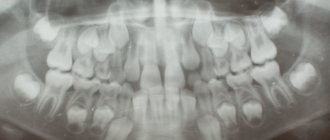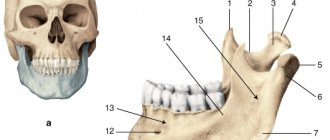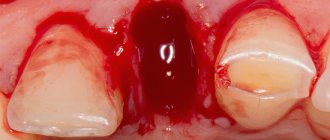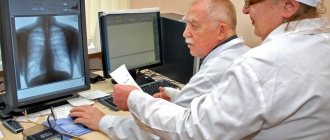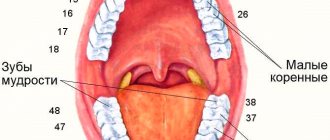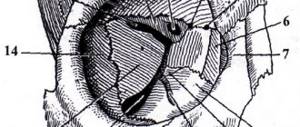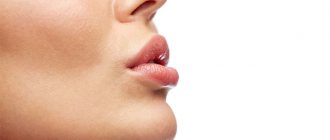822
Depending on the individual characteristics of the patient’s oral cavity, the dentist may recommend installing braces on the fangs, removing a premolar to change the position of the canine, or other methods of surgical correction of a cosmetic and physiological defect.
Despite the skepticism towards this method of treatment, doctors recommend it due to the fact that it has virtually no contraindications for use; the use of the systems makes it possible to correct any pathology of the dentition, both in children and adults.
The results of therapy using braces are noticeable after just a few months of wearing, and the latest products are made from materials that are hardly noticeable in the patient’s mouth.
Types of anomalies
The canines are located behind the incisors in the front corners of the upper and lower jaw, have a crown and a fairly long root, which makes them one of the strongest teeth in the oral cavity.
Orthodontists identify the most typical types of anomalies of row elements:
- Fangs that have not fully erupted , which prevents them from fulfilling their functional purpose, which is to break the fibers of the food they eat.
- The size is too large or short , affecting the deterioration of the bite.
- The location of the fangs, in which they are covered by other teeth and are located on the side of the mucous membranes of the mouth, in which they lose the ability to work in accordance with their functional purpose.
- Fangs turned in different directions along the vertical axis relative to the normal position of the elements in the jaw are considered defects that worsen the appearance of the patient’s smile area.
Note! One of the most unaesthetic types of curvature is a situation in which these teeth protrude from the jaws where they are located, forming the so-called “vampire smile”.
Its characteristic feature is that the protruding elements seem to support the anterior corners of the oral cavity.
In this case, as prescribed by orthodontists, bite correction with braces is indicated.
The need to straighten, pull out a fang or correct an incorrect position of an element in the jaw using braces is determined by the dentist for each patient individually after assessing the nature and severity of the disease.
Why and do braces always rub your cheeks, what to do in such a situation.
Come here if you are interested in the difference between staples and braces.
At this address https://www.vash-dentist.ru/ortodontiya/breketyi/vestibulyarnyie/shataetsya-zub.html we will find out why and how long a tooth is loose under braces.
The role of canines in the dentofacial system
Fangs are the most powerful teeth in humans. These are the only units that, during evolution, have not lost their original, “animal” form. People tear food with them. This makes chewing large pieces easier.
If you count from the center of the dentition, the canines - the third teeth - are located immediately behind the incisors. They are easy to spot due to their cone-shaped shape. Their roots are very deep. The units are load-bearing and play an important role in the formation of a smile.
Since when changing from a milk bite to a permanent one, the third teeth are replaced later than the others, sometimes there is no space left on the jaw. Therefore it is possible:
- turning units in different directions;
- growing above or behind the row;
- incomplete eruption.
Fangs are the most powerful teeth in humans.
Important! Less often, problems arise due to destruction by caries, injuries - dislocation, fracture. The third tooth is little susceptible to mechanical or infectious damage.
The third teeth, trying to make room, displace the remaining bone structures. As a result, the bite becomes distorted and the enamel is erased due to improper load. This leads to aesthetic defects, diseases of the oral cavity, and digestive system.
Reasons for development
Orthodontists name several reasons that cause the development of anomalies, among which it should be noted:
- late appearance , in which the teeth that had previously erupted by the age of 9–12 years have already taken their place, and the last growing canines go beyond the row;
- growth of a wisdom tooth , causing a displacement of the position of the fang;
- discrepancy between the sizes of teeth and jaw , in which, due to genetic predisposition, a child can inherit a small jaw from one parent, and rather large fangs from the other.
In addition to the above reasons, the appearance of dystopia may be associated with untimely replacement of baby teeth with permanent units.
Why is it dangerous to pull out fangs?
Removing the upper teeth, which interfere and cause aesthetic problems, seems to be a way out only at first glance. No specialist will remove it without good reason.
Removing these units is painful and dangerous for the following reasons:
- They play a significant role in chewing food, so their absence will complicate the process. Additionally, when removing the upper teeth, problems with diction are possible.
- If some of the eye teeth are missing, other units begin to perform their task, experiencing an unnatural load. This leads to rapid wear, weakening, disruption of the symmetry of the face, bite, and serious health problems.
- The deep position and unique shape virtually eliminate their susceptibility to caries. This means that the infection will not spread to neighboring teeth.
- These are the most stable teeth. They do not allow the incisors and molars to grind down when the jaws are compressed.
Before removing the upper tooth, the surgeon thinks through the tactics of manipulation, based on an X-ray of the patient’s jaw. He looks at how deep the root is planted and whether there is any curvature (even the slightest curvature makes the procedure even more complicated). The patient is positioned in a chair with the back slightly reclined, the doctor's position is in front and to the right of him. Extirpation is carried out in the following sequence:
- separation of the gums from the alveolar margin;
- separation of the neck of the tooth and the circular ligament;
- advancement of the forceps, their fixation;
- gentle rocking of the tooth, during which the periodontal tissue connecting its root with the walls of the socket is broken;
- tooth extraction;
- inspection of the hole, removal of fragments;
- wound treatment.
The success of removal largely depends on the experience and qualifications of the surgeon. When the specialist is convinced that the bleeding from the hole has stopped, he will give instructions on how to care for the operation site and schedule a routine examination. Despite proper care of the wound after canine removal, complications are possible. If pain intensifies, bleeding from the socket resumes, or general malaise occurs, there is no need to wait for a scheduled visit to the doctor. You need to see a dentist urgently.
Treatment tactics
According to medical statistics, canine dystopia is one of the most common malocclusions.
After examining the patient and taking an x-ray of the patient’s jaw, depending on the stage and type of disorder, as well as the patient’s age, the dentist recommends one of the following methods for eliminating the pathology:
- Extirpation of a wisdom tooth is performed in cases where it is established that it was the growth of this element of the row that caused the appearance of the disorder.
- Installing a prosthesis allows you to correct the position, but is a fairly expensive option for correcting your bite.
- Treatment of the first premolar, which is the tooth next to the canine, to convert it into a canine, is used when there is no natural unit in the series.
- Tooth repositioning is a procedure performed using local anesthetics and designed to return the element to its original position, for example, after dislocation.
- The purpose of correcting the position using braces or other orthodontic devices, before which it is necessary to perform an extraction, then move the canine to its proper place and fix it with removable structures.
Important! Dentists note that when choosing methods for correcting the disorder, orthodontists take into account the fact that removable plates are excellent for correcting malocclusion in children under 12 years of age. With their use, the position of developing teeth is corrected within 12–25 weeks.
The optimal case for prescribing braces is to eliminate dystopia in adolescents aged 14–15 years, since in patients of older age groups, the use of this method without prior surgical intervention will not provide the desired effect.
In some cases, if the patient does not want to install braces, the orthodontist may recommend replacing them with removable aligners or veneers.
The former have a longer period of correction of the anomaly, and the latter can be used in the absence of functional changes in the pathological element.
Is whitening always required after removing braces and what is the best method to use?
In this publication, we will find out whether the price of titanium braces corresponds to their quality.
Here https://www.vash-dentist.ru/ortodontiya/breketyi/vestibulyarnyie/avalon-kak-garantiya-kachestvennogo.html we will look at the design of Avalon braces.
Crooked fangs: methods for correcting smile imperfections
The canines of the permanent dentition erupt on average at the age of 11-12 years, when the incisors and premolars “in the neighborhood” already take their places in the dentition. Therefore, often there is not enough space left for the normal growth of the fangs, and they take an incorrect position, moving forward, to the side or deeper into the oral cavity. Anomalies in canine eruption are not only an aesthetic problem. Bite problems negatively affect the functioning of the digestive tract, leading to breathing problems, diction, and the development of dental and ENT diseases. Let's find out how to fix protruding fangs at different ages.
2 style=”text-align: center;”>Causes of problematic canine growth
Incorrect placement of fangs in the dentition is a very common orthodontic anomaly. Heredity may be the cause. Take a closer look at the smiles of your close relatives; most likely, some of them also have bite problems. But even if the parents do not have malocclusion, their child could have inherited from them some features of the dental system that caused abnormal jaw closure. For example, the baby could “get” wide crowns of teeth from the mother, and a narrow jaw from the father. As a result, the teeth will grow crowded and the canines may become out of position.
Crooked teeth can be inherited by a child.
In addition, supernumerary teeth can cause abnormal growth of canines. According to statistics, almost 5% of all people on the planet grow more than 32 teeth. Of course, there is no room on the jaw for “extra” teeth. Then either the supernumerary teeth grow outside the dentition, or others have to “move”, and it is possible that they will become fangs.
One of the main reasons why there may be a need to correct fangs is poor quality dental care at a young age. If in childhood the child brushed his baby teeth poorly or did not do it at all, the result may be the need for their removal or falling out prematurely.
Note: the features of the histological structure (thin and weakly mineralized enamel) of baby teeth make them more susceptible to the development of caries.
Parents should know that the condition of baby teeth affects the health of primary teeth. After all, the rudiments of permanent teeth are located under the roots of milk teeth. In addition, if a baby tooth falls out prematurely or is removed, the permanent one may grow crookedly, since it is deprived of the correct “landmark” when erupting.
We recommend finding out what bite is considered ideal.
When a large number of teeth are lost, it becomes necessary to install a removable denture. We advise you to familiarize yourself with the features of a telescopic prosthesis without a palate.
Curvature of the fangs can also be caused by bad habits of the child in childhood. If a baby sucks a pacifier or finger for too long, the infantile type of swallowing inherent in babies may not develop into an adult. Because of this, when swallowing, the child's tongue will rest against the teeth, putting pressure on them and leading to their curvature and changes in the bite.
But the problem can become relevant even in adulthood. If, when a permanent tooth is lost, the “gap” in the row is not closed with a prosthesis or implant, the adjacent units will gradually move, trying to fill the empty space. The result can be crooked teeth and a broken bite.
2 style=”text-align: center;”>How to fix crooked fangs?
Modern dentistry has great opportunities, including in such matters as the need to correct fangs. If the canines are abnormally positioned, you need to contact an orthodontist, who, after assessing the condition of the oral cavity and the complexity of the case, will be able to draw up a treatment plan.
Important: the younger the patient, the more effective and faster the orthodontic treatment will be. For comparison, in adolescence, it will take 1-1.5 years to correct defects in the dentition, while in order to correct the same defect, an adult will have to be observed by an orthodontist for 2-3 years.
The most effective method to date for correcting malocclusion and dentition deficiencies is the installation of a brace system. Braces can be used from the age of 12. There is no maximum age threshold, that is, both 30 and 40 years old can undergo orthodontic treatment, of course, in the absence of contraindications.
Up to the age of 12, treatment can be carried out using removable structures - trainers and plates. Their effectiveness is much lower than that of braces, but caring for the device itself and the teeth is much easier. In addition, the cost of treatment will be significantly lower.
Braces are the most effective way to correct crooked fangs.
3 style=»text-align: center;»>Correction of fangs with braces
Braces are permanent orthodontic devices that are attached to the teeth with heavy-duty cement. The operating principle of the bracket system is based on the fact that the active structural element – the arch – has shape memory. After the arch is fixed in the grooves of the bracket plates, it will tend to take the shape of the correct dentition, putting pressure on the teeth and moving them.
Today there are several types of braces systems. First of all, braces are divided into ligature and non-ligature. They differ in the way the arc is fixed in the grooves of the plates. In ligature systems, the arc is held using thin elastic bands or wires - ligatures. Ligature-free systems have locks built into the braces plates. They are distinguished by increased comfort to wear and ease of changing arches.
Lingual braces will help hide orthodontic treatment from prying eyes.
Classic braces are installed on the front surface of the teeth, which is in contact with the mucous membrane of the lips. Such systems are called vestibular. But in recent years, people with malocclusions have the opportunity to install discreet lingual braces. Their peculiarity is that they are fixed on the inner, lingual surface of the teeth. Such systems are chosen by public people for whom it is important to hide the fact of undergoing orthodontic treatment from others. Lingual systems are difficult to maintain and are much more expensive than classic vestibular systems.
Depending on the material used in the manufacture of braces, they can be metal, ceramic, or sapphire. It is possible to make braces even from gold.
3 style=”text-align: center;”>Alternative methods
Braces are not the only way to correct crooked fangs. In addition to fixed orthodontic structures, correction of permanent occlusion can be carried out using aligners - removable transparent aligners. Unlike braces, aligners do not disrupt the aesthetics of a smile, do not rub the mucous membrane, and do not complicate dental care. They look like silicone pads that follow the shape of the teeth. They fit tightly to the surface of the teeth, applying pressure in the right areas. Due to this, the effect of teeth straightening is achieved.
Aligners need to be worn almost around the clock with breaks for meals and oral hygiene. Only in this case can you count on the effectiveness of treatment. That is, mouthguards are suitable only for conscientious patients who are able to strictly follow all doctor’s recommendations. The duration of treatment with aligners is approximately the same as with braces.
Find out how effective Pregnadent toothpaste is for pregnant women.
Read: what a children's toothbrush should be.
We advise you to familiarize yourself with the best models of Omron sonic toothbrushes.
In addition to orthodontic treatment, crooked fangs can be corrected using microprosthetics. Aesthetic dentistry offers the installation of veneers and lumineers on teeth to correct minor imperfections. They are thin porcelain plates that are fixed to the front surfaces of the teeth. However, for severe curvatures, this method is ineffective. In addition, it is worth keeping in mind that wearing microprostheses will be lifelong, since the tooth will have to be ground down to install them. If the fangs are healthy but positioned abnormally, it is better to resort to orthodontic treatment. It is advisable to carry out microprosthetics on already treated teeth.
Crooked fangs certainly don't add beauty to one's appearance. In addition, incorrectly positioned teeth are more difficult to clean; plaque accumulates on them more intensively, which provokes the development of caries and gingivitis. Abnormally positioned fangs affect the quality of chewing food, which leads to digestive problems. Growing crooked teeth can cause a person to have complexes, and in adolescence, cause ridicule from peers. All these problems can be prevented by contacting a competent orthodontist.
Leveling steps
After receiving an x-ray of the oral cavity, the dentist chooses the optimal method of treatment to restore a beautiful appearance and restore functional abilities to the unit with pathologies.
Note! If no change in the position of elements other than the fangs is detected, the orthodontist may recommend the installation of braces aimed at correcting the position of one tooth.
Correction of the position most often occurs within 1–2 years.
In other cases, a visit to the dentist to eliminate dystopia by installing braces may include performing the following procedures:
- performing treatment for diseases of the oral cavity , getting rid of caries, plaque, deposits of mineral components, carrying out sanitation of the oral cavity;
- A detailed examination of the oral cavity is performed using X-rays, and impressions of the patient’s jaws are made, on the basis of which an individual design of a brace system for bite correction is made.
Depending on the contraindications and financial capabilities of the patient, the orthodontist may offer the production of low-cost metal structures or products that have a more attractive lingual appearance. - the dentist assesses the presence of a sufficient amount of free space in the patient’s oral cavity, in the absence of which he can consider options for expanding the jaw using tissue augmentation or performing extirpation of a premolar, which does not play an important role in the process of chewing food.
If the patient is found to have a too crowded arrangement of the second and fourth elements, given a choice, the dentist recommends eliminating the fourth, fifth or sixth unit.Expansion of the jaw space is used when a slight protrusion of the canine relative to the normal position in the row is detected.
- At the last stage, the manufactured structure is installed and the corrective arc is activated.
Important! Many dentists note the need for installation (carried out a year after installation of the bracket system) and wearing orthoelastics, which ensure the required contact between the teeth.
After correcting the position of the fangs in the oral cavity and stabilizing them, the brace system is removed, and the result of the therapy is secured by selecting and wearing retainers.
Violations of the correct position of the fangs
The most common reason for visiting an orthodontist is the need to straighten incisors . Every third patient needs correction of these teeth.
The manifestation of canine defects occurs in the following situations:
- Covering with other teeth.
- Rotate in different directions.
- Incorrect height or small dimensions.
- Insufficiently cut fangs.
Some call this arrangement of fangs a vampire smile. Meanwhile, the problem is not even an aesthetically unpleasant appearance, but serious disturbances in eating. The corners of the mouth are raised by the fangs, and treatment is only possible with the installation of braces.
Expected Result
The duration of wearing the structure depends on many factors, the most important of which dentists include:
- Accuracy of installation of the bracket system , in which the orthodontist must accurately maintain such parameters as the angle of inclination of the structure, the width and height of the installation, determined during the preparatory procedures.
- The degree of deformation of the elements of a row , at which more complex pathologies are eliminated within 2–3 years, while it takes 1–1.5 years to correct the position with minor deviations.
- Correct use and compliance with medical recommendations regarding oral care, limiting the intake of certain products, etc.
- Patient's age , since dentists emphasize that when seeking medical help at a young age, correcting the bite takes 3-5 times less time.
During the therapy, static pressure occurs on the tissue surrounding the teeth firmly fixed in the sockets. As a result, in the direction of pressure, an area is released into which the abnormal tooth is displaced.
On average, the wearing time of the structure is 1.5–2 years; in more severe cases, this period increases to 3 years.
However, the patient will receive the result with 100% probability, regardless of the degree of curvature and the age of the patient.
The video presents the principle of treatment with braces when there is insufficient space for the eruption of fangs.
Is it possible to do without braces?
Here everything depends on the nature of the pathology, so the decision is made by the attending physician. There are ways to correct fangs without braces, but their use is not justified in every case. For adults, the braces system is most preferable.
Children may be prescribed flexi plates, night guards, and trainers. For adults, removable mouth guards are suitable and should be worn for 2 to 3 years. For minor defects that are only such from an aesthetic point of view, veneers or lumineers can be installed. They will camouflage a protruding tooth without moving it.
Consequences of refusing treatment
Despite the high efficiency of the described structures, some patients refuse to have them installed.
Among the most common reasons for this behavior, in addition to fear of deterioration in the appearance of the oral cavity, orthodontists name:
- the presence of relative or absolute contraindications to the procedure;
- long periods of wearing braces;
- high cost in comparison with other systems that provide correction of the position of the element and correction of the bite;
- long recovery period after completion of treatment.
In response, supporters of bite correction emphasize that in addition to preserving the integrity of the tooth, which has important functional and aesthetic significance, performing the procedure:
- Prevents the development of bruxism.
- Restores the normal process of eating, causing restriction when absent or malfunctioning.
- Prevents the development of dysfunction of the joint that connects the upper and lower jaws.
- Returns the correct shape and creates an attractive oval face that suffers from any problems with bite.
In addition to the listed functions, correction of dental anomalies restores confidence to the patient and eliminates the development of complexes and psychological problems associated with dystopia.
Consequences of deletion
Removing fangs is not recommended at all. Extraction is carried out only in cases of severe destruction. If there are aesthetic problems or bite defects, orthodontic treatment is preferred.
If you pull them out, the following complications appear:
- violation of facial features - the corners of the lips fall down;
- inability to fully control facial muscles;
- displacement of other units in unpredictable directions;
- increased abrasion of enamel due to uneven load;
- difficulty gnawing and chewing food;
- change in occlusion (closing) of the jaws - leads to increased wear of enamel, and then dentin;
- problems with diction.
Classification of teeth.
Additional Information! The large upper units are popularly mistakenly called “eye teeth.” It is believed that removal surgery may affect vision. Apparently they have a common nerve. However, it is not. The organs are innervated by various branches of the trigeminal nerve. The upper canine is the maxillary plexus, or rather its branch, the infraorbital foramen. And the eyes - the 3rd branch - the orbital nerve. It is not responsible for innervation of the jaw.
Therefore, such teeth can only be pulled out for acute medical reasons. In other cases, they prefer to use other corrective methods.
Reviews
Installing braces to correct the shape and position of the fangs in a row has advantages and disadvantages, depending on the individual characteristics of the patient.
Because of this, every personal experience review you provide can be critical to people considering undergoing this procedure.
You can comment on the article or leave feedback on the material you read in a special form located below this text.
If you find an error, please select a piece of text and press Ctrl+Enter.
Tags: braces vestibular braces
Did you like the article? stay tuned
Previous article
Secrets of caring for veneers to ensure long-term service
Next article
What color of veneers to choose to achieve maximum aesthetic results
How dentists fight dystopia of “eye” teeth
Determining the curvature of the fangs is quite simple - to do this, the dentist just needs to examine the condition of the client’s oral cavity. When choosing a treatment method, the following criteria are taken into account:
- patient's age;
- features of the existing anomaly;
- degree of neglect of dental pathology.
To remove the curvature and force the canine into the correct position, the doctor may resort to the following treatment options:
- installation of braces on fangs;
- use of mouth guards;
- removal of “eights” (necessary if they are the cause of a dental anomaly);
- transformation of the first molar into a canine if the latter is missing;
- reposition (used exclusively in the most severe cases).
The sooner treatment of the curvature is started, the higher the likelihood of its complete elimination in a short time. If we are talking about providing orthodontic care to children under twelve years of age, then they are advised to wear removable plates. Typically, this method can achieve a beautiful smile in early adolescence in just six months.
Teenagers fourteen years of age and older can return the canine to its natural place with the help of braces. Adults often have to not only wear braces, but also undergo a simple surgical operation.
Is it possible to improve the bite without installing braces on the canines?
Of course, braces are the most practical, reliable and effective way to straighten teeth today. But it happens that for some reason a person does not want to wear them. This is possible due to the high cost of treatment, its long duration, and the unattractive appearance of the structures.
At the dentist's discretion, such a patient may be offered alternative methods. So, if we are talking about children, then to achieve the goal they can:
- wear custom-made mouth guards at night;
- wear soft removable plates;
- use trainers (these are devices that only affect warped units).
If an adult wants to straighten his fangs without braces, he may be offered:
- Removable mouthguards. They should be worn for about two to three years, but the dentist, as a rule, cannot give a 100% guarantee of a positive result.
- Installation of veneers. They do not remove the existing defect, but mask it perfectly. A thin, high-strength plate is glued onto the pre-ground tooth, which makes the smile much more harmonious and beautiful.
It is important to understand that only an orthodontist can decide whether to replace braces with other alignment options. If the doctor sees that the curvature is pronounced, mouth guards and plates will not help, he warns about this. In this case, there is no point in trying to correct the bite without braces.
